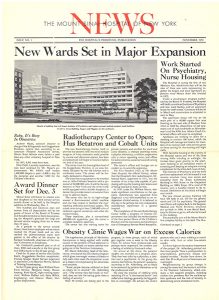This is a guest blog post by Colleen Stapleton. Colleen is a Patient Navigator with the Liver Education and Action Program (LEAP) at Mount Sinai, where she works to improve linkage to care for patients living with Hepatitis C. Colleen is an advocate for innovative health literacy strategies and a volunteer with the the Arthur H. Aufses, Jr., MD Archives at the Icahn School of Medicine at Mount Sinai, where she hopes to complete a history project mapping women’s contributions to the hospital.
Inspiration
Every Tuesday and Thursday before the global shutdown due to SARS-CoV-2, I left my office on the Upper East Side of Manhattan and walked a few blocks down to the Icahn School of Medicine at Mount Sinai, the Annenberg Building on 5th Ave. The building, part of Mount Sinai Health System’s main hospital complex, is a labyrinth of offices and meeting spaces. On the 10th floor, next to IT offices and tucked behind the Otolaryngology suite, is the office of the Arthur H. Aufses, Jr., MD Archives.
I started volunteering with the archives as a way to keep in touch with my personal interests while working as a patient navigator on a public health project in the Mount Sinai Hospital Liver department. My interest in medical devices, most notably the Dalkon Shield IUD tragedy, had introduced me to historian Susan Perry’s fantastic project that took shape in her 1985 book Nightmare.
Perry’s work inspired me to scheme: how could I sharpen my historical eye? How could I hone my training in visual history and explore my personal investment in the stories of women in medicine? What I found in my project scanning and cataloguing Mount Sinai Health System newsletters, however, was much more upbeat than the project that had originally inspired me.
When I reached out to Mount Sinai’s archive I was generously invited to join a team dedicated to preserving the accomplishments of Mount Sinai providers, scientists, and workers. My lunch-hour task would be to make the Archives’ collection of newsletters more accessible to our archivists, and if possible the Archives’ online readership.
Collection

The first issue of The Mount Sinai Hospital News, which ran from 1958-1982
The Aufses Archives has many collections of newsletters. I am starting with the “Mount Sinai Hospital News.” The series consists of several large folders containing two sets of the title. The first newsletter set, set “one”, is known as the “preservation set.” As such, it isn’t handled frequently and contains the best copies. Set “two” contains the copies of the newsletter that are meant to be handled. This handling may occur when inquiries come in from several sources, including relatives of nursing school alumnae, providers previously employed by the hospital or medical school, and hospital or school departments sourcing historical projects, among others. Both sets are stored among the other contents preserved by the Archives.
The archives are not a museum, and so they contain mostly paper-based items and files pertaining to the history of the hospital and medical school. In addition to the collection of newsletters, the Archives includes photographs, meeting minutes, office files, and miscellanea. The collection does house selected objects, including some medical devices, dolls, and even a moulage kit from the 1990s recently passed along to the Emergency Department for use in emergency drills. One of the oldest objects, a ledger indicating notes from one of the first Mount Sinai Beth Israel board meetings, is written by hand in Yiddish and dates back to the 1890s.
The Plan
At the start of the project, the team discussed plans for indexing a collection of newsletters. Would we keep an Excel file of key terms, titles, and dates? Could we also digitize the newsletters? After thinking about the “what” that we would like to make available, we discussed the “how” and “why” of the project. How would the Archives’ online readership access tools to search the newsletter collection? Would we be able to leverage resources to make every issue available online? What were the costs and benefits of spending time uploading each issue digitally?
I was happy to volunteer my help with scanning the newsletters, due in part to my history with an old archive project at the Everson Museum of Art in Syracuse, NY. As a curatorial intern I had been dying to scan the museum’s collection of newspaper clippings highlighting exhibitions and visits by Yoko Ono and John Lennon among other fascinating historical happenings! As it happened, our crew in Syracuse was limited by resource shortages, and scanning would have to be pushed to the next summer.
After some thought and research into searchable PDF text formats, my inclination to scan and upload every issue into our database (then online) was accepted! I was carefully handed a small pile of newsletters, then headed into our neighboring IT office to commandeer the scanner for an hour. The process of scanning had begun!
Watch for Part II, coming soon.
